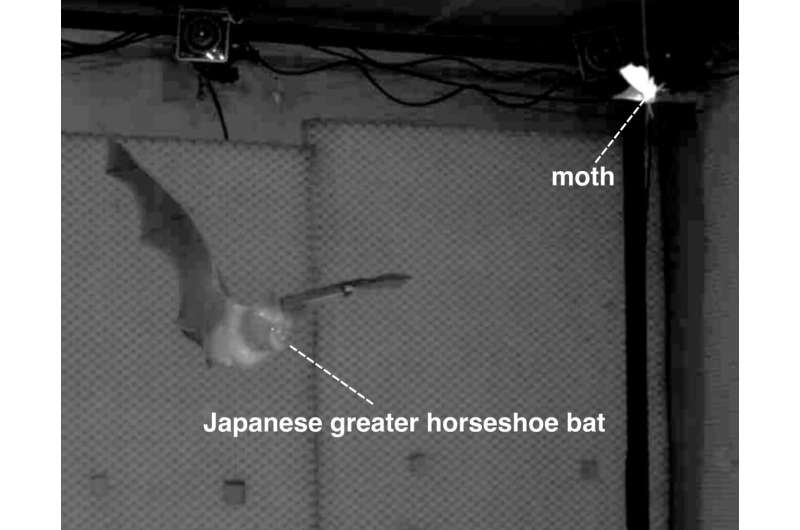This article has been reviewed according to Science X's editorial process and policies. Editors have highlighted the following attributes while ensuring the content's credibility:
fact-checked
peer-reviewed publication
trusted source
proofread
Bats use four key tactics for accurate target tracking

The ability of "target tracking," i.e., keeping a target object in sight, is essential for various activities and has improved in animals and machines through the evolution of life and technology, respectively. Because most sensing systems are inevitably subject to a certain degree of delay caused by information processing, many studies have addressed the challenge of overcoming this delay constraint for more accurate target tracking. At this point, studying animals' sophisticated tracking behavior would bring a significant breakthrough against this fundamental problem.
Taking advantage of free-moving bats chasing moths as a realistic model of target tracking, a team consisting of researchers from the National Institute for Basic Biology of Japan and Doshisha University found that bats used the four key tactics and organized them effectively to track prey accurately. The team also proposed a possible operational rule enabling bats to exercise this strategy efficiently.
"This research was conducted by 3D motion analysis and computer simulations on previously recorded bat-moth interactions, where 3D trajectories and ultrasounds of bats (Rhinolophus nippon) during encounters with prey moths were observed in an experiment chamber, using two high-speed cameras and many microphones on the walls of the chamber," explains Dr. Nozomi Nishiumi of the National Institute for Basic Biology, corresponding author of the report published in Current Biology.
The research team first demonstrated that bats simultaneously deploy the following four tactical elements:
- Prediction of the target direction
- Adjustment of the sensing rate
- Adjustment of the sensing angular range
- Stabilization of the target direction by counter maneuvers
![The combination of three echolocation tactics and one flight tactic works to dramatically improve the tracking accuracy. All tactics can be explained as reactive control to the Line of Sight [LOS] angular velocity. Credit: Nozomi Nishiumi Target tracking strategy in bats: Integration of echolocation and flight tactics](https://scx1.b-cdn.net/csz/news/800a/2024/target-tracking-strate-1.jpg)
In addition, the results from computer simulations demonstrated that the combination of the above tactics greatly and robustly improves the tracking accuracy over a wide range of the delay constraint.
The team also showed that control of those tactics can be explained by a concise rule based on the angular velocity of the target direction, which suggests that bats successfully reduce the burden of multitasking management. Summarizing these findings, the team proposed our conceptual framework for orchestrating several tactics for efficient target tracking.
"Although we used active-sensing bats as subjects, the problem of delay in target tracking and the countermeasures against it are common in various active/passive-sensing animals and devices," explains Dr. Nishiumi.
Through the demonstration of the sophisticated strategy used by bats, their findings would provide insights into the understanding and development of a wide range of objects that engage in target tracking.
More information: Nozomi Nishiumi et al, Bats integrate multiple echolocation and flight tactics to track prey, Current Biology (2024). DOI: 10.1016/j.cub.2024.05.062
Journal information: Current Biology
Provided by National Institutes of Natural Sciences





















